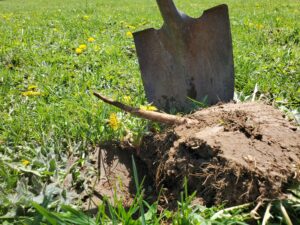Noxious weeds are insidious destroyers of land value and productivity and a legacy one does not want to leave for the next generation. The wind blown seeds of biennials like dandelion, musk and bull thistle are readily visible this time of year in lawns and pasture. While perennial weeds like canadian thistle and horsenettle are often too numerous to control manually, musk and bull thistle can be eradicated with just a shovel or post hole digger.
In a year when fertilizer, herbicide and hay purchases are exceptionally high, managing these noxious weeds manually before they produce a seed head later this summer is a win-win investment of your time.
This weekend, I spent an hour shoveling out one hundred and thirty eight first year and second year rosettes of musk and bull thistle in a four acre section of a permanent pasture. Shoveling out thistle rosettes is a great low intensity whole body workout, and a great way to destress while soaking up vitamin D. Collecting soil from each hole will also work as a randomized soil sample.
The growth habit of non-bolting (first year rosettes) and bolting (second year rosettes) are easily distinquishable from the two leaf stage of leafing out Canadian thistle.

If the infestation is significant, focus your time on just the large dense rosettes that are taller and wider than the low to the ground rosettes. These larger rosettes are most likely second year growth and the ones that will bolt a flower stalk. If allowed to go to seed, each individual plant can send out thousands of wind blown seeds.
While walking the pasture, take note of emerging Canada thistle shoots and calculate if the area can be treated with just a back pack sprayer or is a boom sprayer more appropriate. Other stand reducing weeds like curly dock, stinging nettles and buttercups are easily seen this time of year. Monitoring the proliferation of these weeds in a pasture is a good indication of the pH level and productivity of the existing grass sward. Rumex species are distributed by visiting waterfowl and buttercups are notorious for cropping up after flooding. If hay was purchased from out of state last year and you noticed feed refusal, pay particular attention to areas where hay was fed for signs of common mixed grass hayfield contaminants like Pennsylvania smartweed, multiflora rose and catchweed bedstraw.
If you would like to host a pasture walk this season to identify weeds of concern and learn how to best manage them on your farm in Salem, or nearby in Cumberland or Gloucester County, contact Melissa Bravo at the Salem County office.

